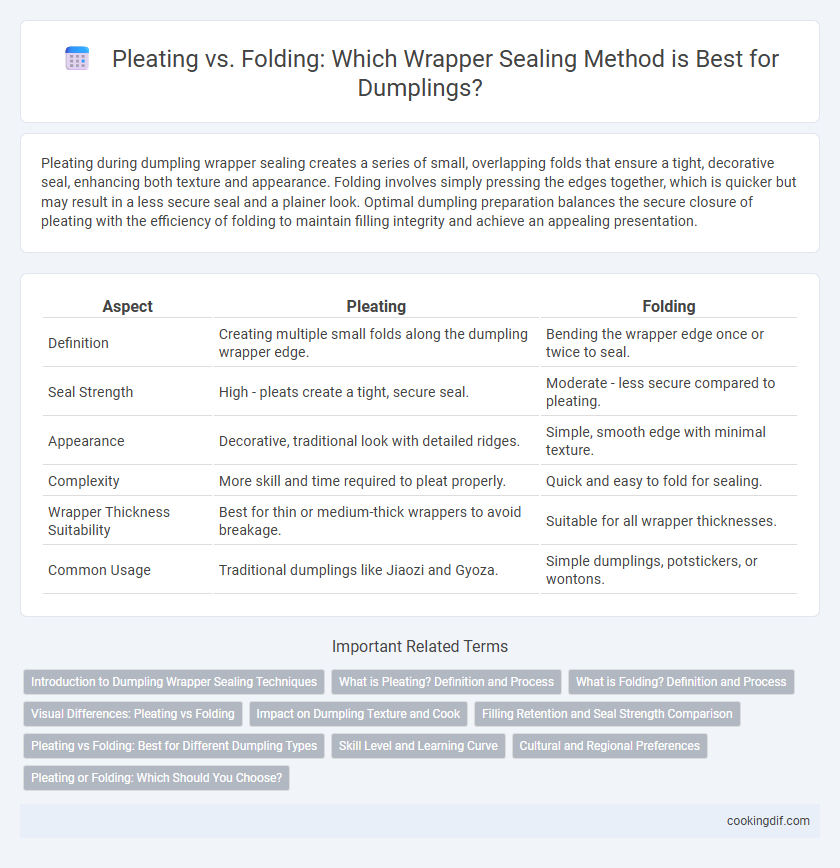Pleating during dumpling wrapper sealing creates a series of small, overlapping folds that ensure a tight, decorative seal, enhancing both texture and appearance. Folding involves simply pressing the edges together, which is quicker but may result in a less secure seal and a plainer look. Optimal dumpling preparation balances the secure closure of pleating with the efficiency of folding to maintain filling integrity and achieve an appealing presentation.
Table of Comparison
| Aspect | Pleating | Folding |
|---|---|---|
| Definition | Creating multiple small folds along the dumpling wrapper edge. | Bending the wrapper edge once or twice to seal. |
| Seal Strength | High - pleats create a tight, secure seal. | Moderate - less secure compared to pleating. |
| Appearance | Decorative, traditional look with detailed ridges. | Simple, smooth edge with minimal texture. |
| Complexity | More skill and time required to pleat properly. | Quick and easy to fold for sealing. |
| Wrapper Thickness Suitability | Best for thin or medium-thick wrappers to avoid breakage. | Suitable for all wrapper thicknesses. |
| Common Usage | Traditional dumplings like Jiaozi and Gyoza. | Simple dumplings, potstickers, or wontons. |
Introduction to Dumpling Wrapper Sealing Techniques
Pleating and folding are essential techniques for sealing dumpling wrappers that ensure the filling stays secure during cooking. Pleating involves creating small, uniform folds along the wrapper edge, resulting in a decorative, crimped seal that enhances both texture and presentation. Folding, on the other hand, simply involves pressing the edges together to form a clean seal, often used for simpler dumplings like gyoza or wontons, prioritizing efficiency and ease.
What is Pleating? Definition and Process
Pleating is a technique used in dumpling making to seal the wrapper by creating small, evenly spaced folds along the edge, enhancing both the visual appeal and structural integrity. The process involves pinching and folding the wrapper's edge in a series of pleats, which helps trap the filling securely inside while allowing steam to circulate during cooking. This method provides a decorative finish and ensures the dumpling remains tightly sealed to prevent leakage.
What is Folding? Definition and Process
Folding in dumpling wrapper sealing involves bending the dough over itself without creating multiple pleats, resulting in a smooth, sealed edge. This process ensures a tight closure by pressing the edges firmly together, preventing filling leakage during cooking. Folding is often preferred for simpler dumpling shapes and quicker preparation while maintaining structural integrity.
Visual Differences: Pleating vs Folding
Pleating creates a textured, ridged edge on dumplings, characterized by multiple small, overlapping folds that form a decorative pattern. Folding produces a simpler, smoother seam where the wrapper edges are pressed together in fewer, broader folds. The pleated edge often appears more intricate and ornate, while folding results in a clean, streamlined look.
Impact on Dumpling Texture and Cook
Pleating dumpling wrappers creates multiple sealed folds that result in a chewier texture and can hold more filling, enhancing steam retention during cooking for a moister interior. Folding produces a simpler, smoother edge that yields a softer bite and quicker, even cooking due to less dough thickness at the seal. The choice between pleating and folding directly impacts dumpling texture and cooking dynamics by influencing dough thickness and steam distribution.
Filling Retention and Seal Strength Comparison
Pleating creates multiple small folds along the dumpling edge, enhancing seal strength by distributing pressure evenly and reducing the risk of filling leakage during cooking. Folding typically involves a single fold or fewer pleats, which may result in weaker sealing and potential gaps where filling can escape. Studies show that pleated seals retain up to 30% more filling and withstand 25% greater internal pressure compared to basic folded seals, making pleating the preferred method for durability and filling retention.
Pleating vs Folding: Best for Different Dumpling Types
Pleating offers a secure and decorative seal ideal for dumplings with fillings that require extra reinforcement, such as pork or vegetable dumplings, ensuring the wrapper holds during boiling or steaming. Folding is best suited for simpler dumplings like potstickers or wontons, providing a quick, tight seal that allows for even cooking and a uniform shape. Choosing between pleating and folding depends on the dumpling's filling moisture and cooking method to optimize texture and presentation.
Skill Level and Learning Curve
Pleating involves creating multiple small, intricate folds along the dumpling wrapper edge, demanding a higher skill level and a steeper learning curve due to its precision and uniformity requirements. Folding, by contrast, is a simpler technique that generally requires less dexterity and is quicker to master, making it ideal for beginners or casual cooks. Mastery of pleating enhances both the aesthetic appeal and structural integrity of dumplings but requires consistent practice to perfect.
Cultural and Regional Preferences
Pleating and folding techniques in dumpling wrapper sealing vary significantly across Asian cultures, reflecting regional culinary traditions and aesthetic preferences. Chinese dumplings often showcase intricate pleating to create a decorative edge that enhances texture and grip during cooking, while Japanese gyoza typically use simpler folding methods prioritizing efficiency and a crisp finish. These cultural distinctions influence not only the dumpling's appearance but also affect cooking methods and regional flavor profiles.
Pleating or Folding: Which Should You Choose?
Pleating offers a decorative and secure seal for dumpling wrappers, creating multiple small folds that help hold the filling tightly and enhance the overall presentation. Folding is simpler and faster, ideal for thicker doughs or beginners seeking a straightforward seal without intricate detail. Choosing between pleating and folding depends on the desired aesthetics and ease of preparation, with pleating favored for visual appeal and folding chosen for practicality.
Pleating vs Folding for wrapper sealing Infographic

 cookingdif.com
cookingdif.com